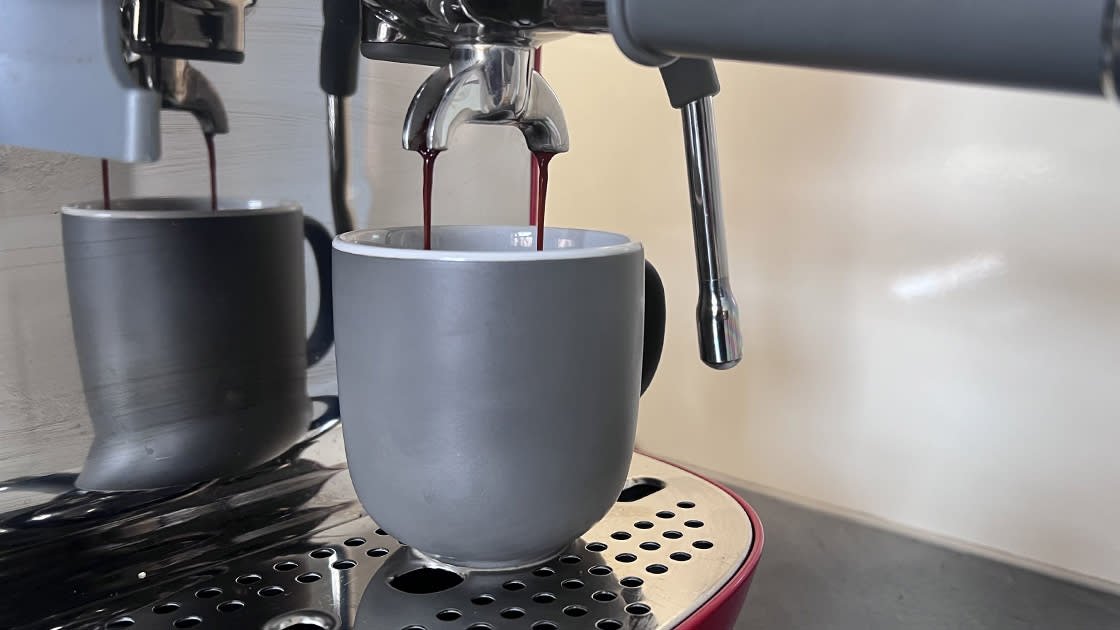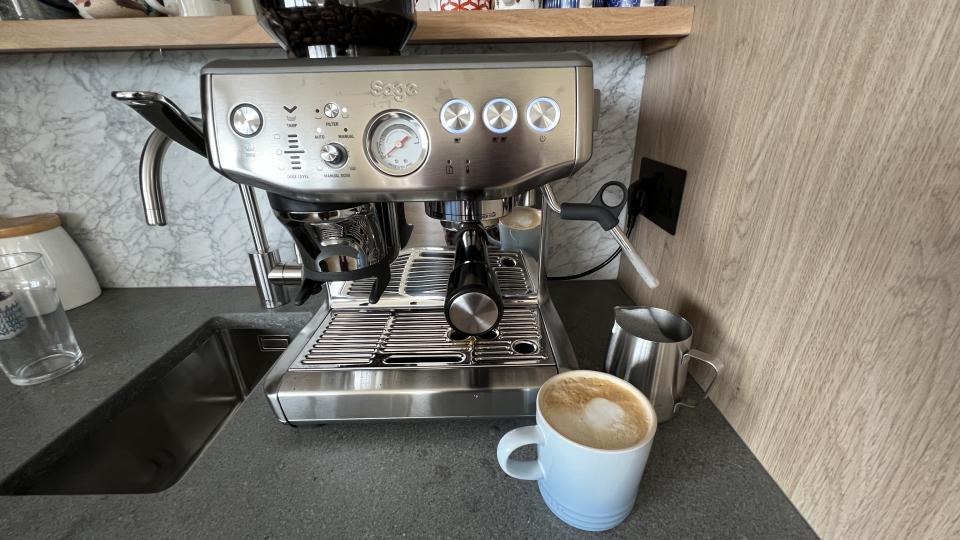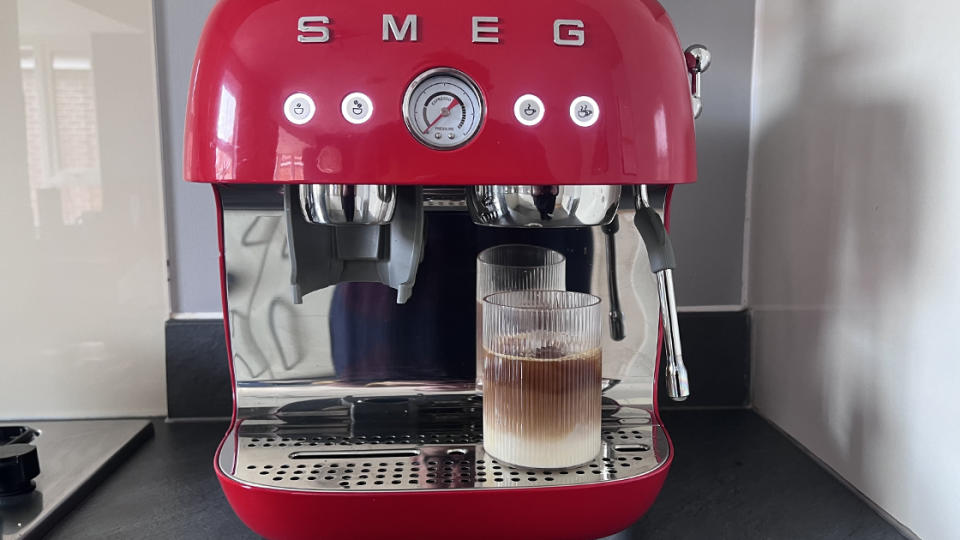3 types of espresso machine—and how to use them

If entering the world of finding the best coffee maker wasn't confusing enough—with names like pour-over, French press, espresso and more being thrown around—even when you choose a method, there are then different types of machines in each category.
This is especially the case with the best espresso machines, many of which don't come cheap, meaning they can't be bought on a whim, or as a gamble.
In simple terms, all espresso machines brew shots of coffee, which can be enjoyed on their own or used in lattes, cappuccinos and more. And they all involve passing water through coffee grounds using pressure.
Yet exactly how they grind that coffee, or create that pressure depends on a number of factors and in this guide I'm going to explain the methods used in the three most popular—manual, semi-automatic and fully automatic.
3 types of espresso machine
Espresso machine types: At a glance
The key differences between the three types of espresso machine are as follows:
Manual espresso machines: Also known as lever machines, manual espresso makers are less common than the semi- and fully automatic models but are popular among barista and coffee aficionados. All steps are manual, including applying the pressure through the grounds.
Semi-automatic espresso machines: These are the preferred choice for many coffee shops and baristas. They offer a mix of manual controls and customisation with automated steps.
Fully automatic espresso machines: Fully automatic models are also known as super automatic espresso machines and every step – from grinding and tamping the grounds to the milk and water—is done automatically at the press of a button.
Manual espresso machines
Manual, or lever espresso machines are the epitome of traditional espresso brewing. The first models are said to date back to 1905 with the launch of the La Pavonia range in Italy and they quickly became popular across Europe and the US. La Pavonia is still considered a leader in the manual espresso machine market and its bestseller is the La Pavoni Europiccola .
These machines get their name from the fact you have to manually push a lever to generate the pressure needed to extract the coffee from the grounds. They give you complete control of every aspect of the brewing process—from the size of the grind to the weight of grounds, amount of pressure, extraction time and more—but that also means they are the least forgiving. This can be both a blessing and a curse: it allows for a highly customized experience but also means that getting any sort of consistency can be challenging, especially for beginners.
As a result, manual espresso machines are best for enthusiasts who enjoy the process of making coffee as much as they do drinking it, and are willing to invest time in mastering the craft. You can experiment with different variables and get a deeper understanding of coffee and brewing.
Despite their relatively simple technology, compared to the bells and whistles of semi-automatic and fully-automatic models, the precision that comes with lever machines can see them cost anywhere from $100-$250 for models including the Flair NEO Flex and ROK Press GC, $700-$800 for mid-range models from SUPERKOP and as much as $1,500+ for models like the La Pavoni PSW-16.
Semi-automatic espresso machines
Semi-automatic coffee makers are likely the espresso machines you're most familiar with. The majority of machines you see in coffee shops, everywhere from global chains like Starbucks to independent stores, are semi-automatic because they allow baristas a certain level of control, with the speed and convenience of automated steps.
All models in this category automate the brewing process, from heating the water to the desired temperature, passing it through the coffee grounds and controlling the pressure. However, you're responsible for setting the grind size and weight, tamping the puck and frothing the milk.
On bean-to-cup models, like the $350 CASABREWS Espresso Machine with grinder, you can adjust the grind size on the machine itself. Or you can buy a standalone grinder, such as the OXO Brew Conical Burr grinder and Fellow Opus grinder. The size of the grind combined with the weight of the grounds used directly influences the amount of pressure created as the water passes through the puck. This then dictates the flavor profile and texture of the espresso shot.

On more advanced semi-automatic espresso machines, you can manually tweak the water temperature, and extraction time. On the $750 Breville Barista Express you can adjust the temperature in two, or four degree increments, for instance. You can also reprogram the extraction time. On the $899 Smeg Espresso Coffee Machine you can additionally reprogram how long you grind the beans for to increase, or decrease the amount and thus change the weight, to coincide with a change in grind size.

Some models, like the $570 Café Bellissimo espresso machine, even come with smart features that let you control the volume and strength via an app. These border on being fully automatic machines but are classed as semi-automatic due to the manual tweaks that can be made on the machine themselves.
Compared to manual machines, semi-automatic machines provide a balance between control and convenience. By keeping water pressure and temperature consistent, they're more user-friendly than manual machines while still offering a level of customisation and experimentation. This is why they're popular with beginners and pros alike.
Fully automatic espresso machines
As their name suggests, fully automatic espresso machines automate every step of brewing process. All you need to do is add the beans or grounds, and press a button.
Whereas manual machines are designed for ultimate customisation, fully automatic machines sit at the opposite end of the spectrum, offering ultimate convenience. They typically feature programmable settings that let you select your preferred coffee style from a built-in display, or app. They then handle everything from grinding the beans to frothing the milk, delivering a consistent cup of espresso with minimal effort.
This is why they're often referred to as super-automatic machines. It's what makes them significantly easier to use, but it's also what sees them being snubbed by coffee purists, due to the lack of control and supposed 'craft'.
Not to mention this convenience and automation tends to come at a price. A top-of-the-range, fully automatic espresso machine like the Jura E8 or De'Longhi PrimaDonna Elite will set you back as much as $2,500, while the Gaggia Accademia costs $1,999. These machines offer a dozen or more drink options, accessed via touchscreen color displays. They allow you to adjust coffee strength, temperature, dose, volume, pre-infusion and flow automatically, at the touch of a button, and often come with commercial-quality steam wands, and auto-frothing carafes. They'll even clean themselves if you want them to. Others, like the $1,799 De'Longhi Eletta Explore come with smart features that put these controls on your phone via a connected app. The Eletta Explore is one of the few fully automatic machines to offer cold brew options, too, pushing the total drink options to 30+.

That said, you don't have to spend this much to get the convenience of fully automatic espresso machines. The Phillips 2200 Series, and 3200 Series cost a relatively cheap $649 and $799 respectively. While neither look as nice as the more expensive models, and they both lack the high number of drink options, they do bring a decent level of consistency and convenience at a more accessible price.
Note, Nespresso and similar pod coffee machines can sometimes, technically, fall under fully automatic categories when shopping online but they're a different type of coffee machine entirely.
3 types of espresso machine: FAQs
How to choose the best espresso machine
Choosing the best espresso machine depends on your personal coffee preferences, skill level, budget, patience and how much control you want over the brewing process.
If you're well-skilled in making coffee—or you want to be—then a manual espresso machine will give you the ultimate in control and customisation. You'll need a lot of patience, and time, to get to grips with the different parameters but you'll be rewarded with the best tasting espresso of your life. There is also a wide range of manual machines to suit different budgets.
If you're not ready to dive straight into lever coffee, you might prefer a semi-automatic espresso machine. These machines allow you almost as much, or as little control as you want or need to suit your lifestyle. More advanced models let you experiment with different parameters and dip your toe into the brewing process, while cheaper models keep things simple and consistent, with an element of customisation. They're the best-of-both-worlds in terms of features, price and quality and this is why they're the most common and popular type of espresso machine.
And if you just want consistent, great-tasting coffee with minimum effort—and don't mind paying for this convenience—then opt for a fully automatic machine.
There are a couple of things to consider though, whichever espresso machine you go for.
In the majority of cases you get what you pay for. There are some brands, particularly the Italian brands, that charge a premium for their name but they also offer some of the most advanced tech, so even then it can be worth paying slightly over the odds for. Cheaper models tend to produce slightly lower quality coffee, or lack some of the more advanced features, and design. This isn't always the case, but it's worth considering what matters to you most when choosing an espresso machine and finding a model to match.
You also need to consider the size of the machine and how much counter space you have. Manual machines tend to be small and compact, due to the lack of internals. Fully automatic, with all their bells and whistles, tend to be large and bulky.
Does the type of espresso machine make a difference?
The answer to this largely depends on what you want or need from an espresso machine but generally speaking, yes, the type of espresso machine makes a difference in the brewing process and the final coffee quality.
Manual machines offer the highest level of control but require more skill. When you get all the parameters right, they make the highest quality coffee but they're less forgiving.
Semi-automatic machines offer a balance between control and convenience, making them suitable for most beginners and home baristas.
Fully automatic machines offer the most convenience and consistency but can limit your ability to customize the brewing process. This can cause your coffee to lack nuance, compared to semi-automatic and manual methods, but it can also save you a huge amount of time and effort.

